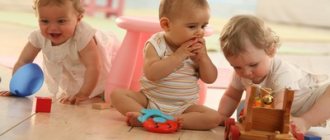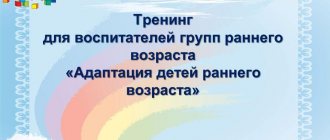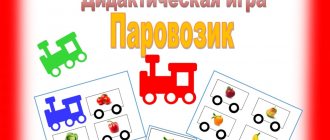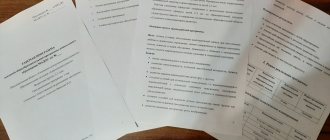Article:
A preschool educational psychologist is a specialist who carries out complex psychological work with a child: educational, developmental, correctional.
One of the conditions for the effectiveness of his work is close cooperation with educators, since coherence of work, unity of requirements and approaches, sincere interest in the harmonious development of the child of both specialists is the basis for the effectiveness of not only their joint activities, but also the educational process as a whole. It is a well-known fact that the main goal of the preschool level of education is to prepare children for school, and this process acquires particular significance in senior and preparatory groups.
Psychological readiness for school is an integrative characteristic, the components of which are: intellectual, personal, emotional-volitional and socio-psychological (communicative) readiness. And if the development of the first three is given enough attention within the educational activities of preschool educational institutions, then the formation of communicative competence of preschoolers often remains a spontaneous process. Although the child’s adaptation to school and the success of his education largely depend on the level of its development.
The complexity of the formation and development of communicative competence in kindergarten is due, in our opinion, to the fact that it requires the teacher to continuously work in a given direction. Since communication is a constant companion to any child’s activity: routine moments, activities, playing together, interaction with others. Consequently, professional activities to develop the child’s communication skills occur throughout the teacher’s entire working day.
By communicative competence of preschoolers we understand the integrative personality quality being formed, which includes flexible mastery of ways to establish and maintain relationships, the development of the need for communication, and the ability to act together. The realities of our time (fast pace of life, busy parents, high level of technocratization of society) have a negative impact on the development of children's communication skills. By becoming dependent on computer games, watching TV shows and cartoons that are not age appropriate and have no educational potential, the child ceases to need live communication not only with peers, but also with adults.
It's no secret that in almost every kindergarten group there are children with communication disorders. These may be: inability to establish contact, avoidance of communication, conflicts, unwillingness to take into account the opinions and needs of others. A child who cannot communicate adequately is not interesting to others, feels wounded and rejected, which can lead to two polar groups of consequences: anxiety, shyness, isolation or aggressiveness.
What is the algorithm for the joint activities of a teacher-psychologist and a teacher to develop communicative competence?
1. Joint compilation of psychological characteristics of children in the group, based on the diagnosis of a psychologist and the daily pedagogical observation of the teacher. This stage contributes to the expedient design of classes and the optimal distribution of participants during exercises, harmonizing the relationship between the teacher and children based on an individual approach.
2. Joint participation in classes, based on unconditional acceptance of the child as he is (Remember that there are no difficult children, there are children with whom it is difficult).
3. The teacher’s control over children in the group’s compliance with the rules, skills and abilities developed in classes, facilitating their faster consolidation.
Classes to develop communication skills should contribute to:
- formation of the need for communication;
- strengthening the skills of establishing and maintaining contacts,
- developing qualities that help in communication and eliminating those that interfere,
- formation of skills for joint activities, which is possible only if the rules are followed and respectful towards other children.
Examples of exercises aimed at developing communication skills can be: “Say hello with different parts of the body”, “How we are alike”, “Rules of friendship”, “Locomotive “I am good””, Joint drawing.”
Good luck to you in such a difficult but exciting task - raising the younger generation!
Methodological recommendations on the topic: “Methods of group work of a teacher-psychologist with a preschool educational institution team”
Methodological recommendations on the topic: “Methods of group work of a teacher-psychologist with a preschool educational institution team”
Teacher-psychologist Safonova T.A.
In order to increase the psychological competence of preschool educational institutions teachers, including orientation in the patterns of child development, in matters of education and conditions in preschool educational institutions for the development of personal formations, an educational psychologist can use a number of methods:
- lecture;
- workshop;
- group consultation;
- training;
- brainstorming method;
- business game;
- round table;
- conversation.
It is also necessary to include types of work that would help improve the emotional well-being of teachers, relieve tension and feelings of discomfort. The most effective are relaxation breaks.
Let's look at some methods.
1. Lecture
. This is a method of transferring ready-made knowledge by a lecturer to an audience. When working with teachers, it is rational to use it in combination with other methods of a more practical orientation, in connection with the characteristics of the audience and the target field of their activity. The structure of the lecture should include the key points of the problem and have a logical clarity of construction:
- introduction (relevance, practical significance of the topic or problem);
- main part (formulation of basic concepts, disclosure of structure and relationships, classification);
- conclusion (highlighting the main idea, summarizing).
There are several types of lectures:
Lecture-conversation.
It takes place in direct contact with the audience. With its help, the presenter has the opportunity to attract the attention of listeners to the key points of the lecture and indirectly use collective experience and knowledge. The negative point is that during a lecture-conversation it is impossible to involve all participants in the discussion.
Lecture-discussion.
It involves the use of a free exchange of opinions between the presenter and listeners between logically structured blocks of the lecture, which allows step-by-step control of the process of mastering the material. To effectively conduct a lecture-discussion, it is necessary to prepare questions. This method allows the presenter to control the opinion of the majority and change the negative attitudes of individual audience members.
Lecture-consultation.
It is most effective when presenting practical material. Involves the lecturer's answers to questions from listeners after presenting the topic. This takes up approximately half of the total lecture time. This method allows the presenter to track the effectiveness of the lecture, discover the problems of listeners, their professional and personal orientation.
These types of lectures can be used in work with both teachers and parents.
There are several other types of lectures (lecture with intensive feedback, lecture with analysis of micro-situations, etc.). At their core, they duplicate in some aspects the above, and therefore do not require detailed consideration.
- Workshop.
A type of lesson whose purpose is to provide the opportunity for the practical use of theoretical knowledge. It involves intensive independent work by the participants and the facilitator on the topic assigned to them. During the workshop, there is a direct exchange of experience, and options for solving certain problems are considered.
- Group consultation. IN
basically has the same structure as an individual consultation. Its psychological meaning is to help a person solve the problem himself, which presupposes the activity of all participants in the consultation and equal positions of the presenter and the audience. The content of the consultation should concern the most important and significant issues identified during observations or surveys. The goal of group counseling should be to help participants solve problems on their own.
4. "Brainstorming"
or brainstorming. This is a method of activating mental activity, designed to produce ideas or solutions to a particular problem. The use of this method must be carried out in accordance with the rules:
a) the group should consist of 7-10 people;
b) criticism of other people's ideas is prohibited; only respect can be shown towards other people's opinions;
c) someone else’s idea can be developed, or you can offer your own;
d) the chairs of the participants should be in a circle;
e) participants must be in a state of emotional and muscular relaxation;
f) All ideas from participants must be recorded. Any ideas can be proposed, even the most
fantastic, and they all have a right to exist. Further, during the accumulation of ideas, the most rational and effective ones in a particular situation are adopted. It is necessary to follow the rule of “4 analogies”:
- direct analogy
(participants are asked to think about how problems similar to this one are solved);
- personal analogy
(participants are asked to enter into the image of the object given in the problem and reason from its point of view);
- symbolic analogy
(participants are asked to imagine solving the problem from the point of view of unreal fairy-tale heroes).
Fantastic analogy (participants are asked to imagine solving the problem from the point of view of unreal fairy-tale heroes).
There are other methods for activating the group’s thought processes:
- focal object method
(the essence is that the characteristics of several randomly selected objects are transferred to the object in focus, resulting in unusual combinations, the development of which leads to the development of original ideas);
- test question method
(involves the use of questions aimed at changing objects, weight, size, material, shape, direction, etc.).
The brainstorming method stimulates the development of group dynamics, which should not be spontaneous; the task of the leader is to indirectly direct this movement, indirectly regulate it. It is important to catch the tension that has arisen in the relations of the participants in time and smooth it out.
5. Training.
An active method of group work, the use of which requires compliance with certain rules. The criteria for selecting training participants are as follows:
- voluntariness of joining the group, desire to participate in the training;
- approximately the same age of the participants (it was noted that after 45 years, participation in the training is not effective);
- the number of group members should not exceed 12 people;
— the training group should involve people who are strangers to each other;
- People with obvious physical defects and mental disorders should not participate in the training.
The facilitator must have a certificate indicating preparation for leading training groups.
In teaching teams, it is more effective to use elements of training, due to the fact that organizing full-fledged training groups is most often impossible. This is a consequence of a number of features: work hours, the overlap of personal relationships with business ones, wide age boundaries, etc.
However, if the situation in the teaching team meets the requirements for their participants in solving a number of problems, training seminars or workshops can be considered a fairly highly effective equivalent of training.
6. Business game.
Refers to gaming technologies in the educational process. This is a type of activity that involves solving any problems in a situation of artificially created conditions. A business game creates an emotionally positive mood for the participants, which allows them to avoid tension while solving a game problem. During business games the following are simulated:
- relationships;
- interactions;
— organizational and structural aspects. Before starting a business game, the participants must develop rules of interaction.
— discussion of what is happening in the group at the level of personal and business relationships should be “here and now”;
- all expressed ideas have the right to exist, since even the most implausible idea can positively influence the development of a group decision;
- statements must be on topic, empty ranting must be excluded;
- your opinion or position must be expressed in a concise form, saving the time of other participants;
- criticism of other people's ideas should be excluded; they can only be developed and supported.
Evidence of the effectiveness of group work during a business game is the appearance of so-called increments among the participants.
Conducting a business game requires a certain deployment logic. Before it starts, the presenter must prepare documentation required by the course of the game. The documentation also includes a dictionary of terms and concepts that ensures their unambiguous interpretation.
Next you need:
- highlight an object or process modeled in the game;
- prepare a game prospectus (disclose its content, conditions of use, in other words, explain what activity is modeled in the game, where the scope of its application is);
- develop a scenario that includes characteristics of the game object and the establishment of roles;
- organize a gaming environment that is closest to real conditions;
- establish regulations;
- appoint an administrator who will lead the group of game organizers;
- form gaming teams;
- distribute roles;
- create a group of experts to analyze conflicts that have arisen;
- select a counting group (if necessary);
- choose a person to create interference and accidents (if this is provided for by the rules of the game).
In the process of working with teachers, a psychologist can also use methods such as psychotechnical games1. They allow teachers to reduce mental stress, develop their internal potential, and effectively manage their internal state, which will ultimately have a positive impact on professional and personal growth. Such games do not require special organization or expense, and after training, teachers can use them in their daily lives.
Relaxation games.
Necessary for removing internal “clamps” and tension. Allows you to gain a sense of stability and relief from stressors. This is a kind of “psychological shower”, necessary for people whose professions involve stressful situations.
Adaptation games.
Designed to optimize the process of professional adaptation of young teachers and, above all, to develop the ability to manage themselves and control their emotional states.
Formula games.
These games are based on the method of verbal self-suggestion. The text of the formulas should be in the form of self-orders that are spoken to oneself. The effectiveness of such games will be quite high if you follow the rules:
- unshakably believe in the power of self-hypnosis formulas;
- when pronouncing the formula, you need to concentrate and concentrate;
- the formula must be repeated 5-7 times;
- the text of the formula should be short and concise;
- the beginning of the formula must include the following statements:
“I can…”, “I know that...”, “I feel that...”, “I am convinced that...”
Formula games can have the following orientation:
- mood for an active position during the day;
- attitude towards confident behavior;
- positive attitude towards work,
children, parents.
Thus, psychological science offers practical psychologists a fairly wide range of methods and forms of active group work with teachers. It is important to choose from them adequate to the goals and needs of a specific group of people - the teaching staff of a preschool institution. The psychologist needs to identify the potential capabilities of teachers, as well as determine the range of problems that exist for them, and based on their analysis, build further work.









